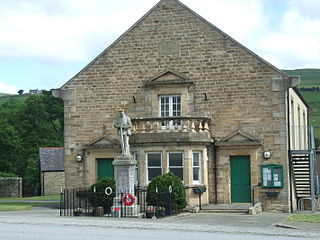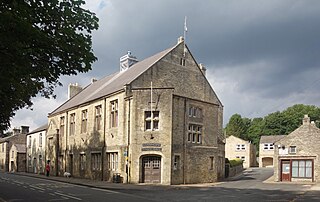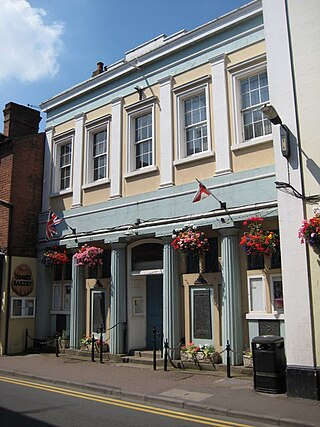
Stanley is a town and civil parish in the ceremonial county and district of County Durham, England. Centred on a hilltop between Chester-le-Street and Consett, Stanley lies south-west of Gateshead.

Sockburn is a village and former civil parish, now in the parish of Neasham, in the Darlington district, in the ceremonial county of Durham, England. It is situated at the apex of a meander of the River Tees, to the south of Darlington, known locally as the Sockburn Peninsula. Today, all that remains of the village is an early nineteenth-century mansion, a ruined church and a farmhouse built in the late eighteenth century.

St John's Chapel is a village in the civil parish of Stanhope, in County Durham, England. It is situated in Weardale, on the south side of the River Wear on the A689 road between Daddry Shield and Ireshopeburn. The 2001 census reported a population of 307.

Wolsingham is a market town in Weardale, County Durham, England. It is situated by the River Wear, between Crook and Stanhope.

Stanhope is a market town and civil parish in the County Durham district, in the ceremonial county of Durham, England. It lies on the River Wear between Eastgate and Frosterley, in the north-east of Weardale. The main A689 road over the Pennines is crossed by the B6278 between Barnard Castle and Shotley Bridge. In 2001 Stanhope had a population of 1,633, in 2019 an estimate of 1,627, and a figure of 1,602 in the 2011 census for the ONS built-up-area which includes Crawleyside. In 2011 the parish population was 4,581.

The baronetcy of Conyers of Horden was created in the Baronetage of England on 14 July 1628 for John Conyers of Horden, County Durham.
Brigadier-General Sir Herbert Conyers Surtees was a British military leader, politician and historical author.

Amersham Market Hall, formerly known as Amersham Town Hall, is a municipal building in the High Street in Amersham, Buckinghamshire, England. The structure is a Grade II* listed building.

Tring Market House is a municipal building in the High Street, Tring, Hertfordshire, England. The structure, which is the meeting place of Tring Town Council, is a Grade II listed building.

Hartlepool Borough Hall is municipal building, which served as the meeting place of the old Hartlepool Borough Council, before it amalgamated with West Hartlepool County Borough Council. It is located on the Headland, Hartlepool in County Durham, England and is a Grade II listed building.

Painswick Town Hall is a municipal building in Victoria Square, Painswick, Gloucestershire, England. The building, which is used as an events venue and also as the offices of Painswick Parish Council, is a Grade II listed building.

Helmsley Town Hall is a municipal building in the Market Place in Helmsley, North Yorkshire, England. The structure, which is used as a community library and a community events centre, is a grade II listed building.

Llanidloes Town Hall is a municipal building in Great Oak Street, Llanidloes in Powys, Wales. The structure, which is the meeting place of Llanidloes Town Council as well as the home of the Llanidloes Museum and the Llanidloes Public Library, is a Grade II listed building.

Ferryhill Town Hall is a municipal building in Chapel Terrace, Ferryhill, County Durham, England. The structure accommodates the offices and meeting place of Ferryhill Town Council.

Chapel-en-le-Frith Town Hall is a municipal building in Market Street, Chapel-en-le-Frith, Derbyshire, England. The structure operates as a community events venue, as well as the offices and meeting place of Chapel-en-le-Frith Parish Council.

Stanhope Town Hall is a former municipal building on Front Street, Stanhope, a town in County Durham, England. The building is not currently in use and is being marketed for sale.
Kearsley Town Hall was a municipal building on Bolton Road in Kearsley, a town in Greater Manchester, in England. The building, which was the headquarters of Kearsley Urban District Council, was demolished in 2013.

Tottington Hall, also known as Tottington Town Hall, is a municipal building in Market Street, Tottington, a town in Greater Manchester in England. The building, which served as the offices and meeting place of Tottington Urban District Council and now operates as a public library, is a grade II listed building.

Upton-upon-Severn Memorial Hall, formerly known as Upton-upon-Severn Town Hall, is a municipal building in Old Street in Upton-upon-Severn, a town in Worcestershire in England. The building, which serves as the offices and meeting place of Upton-upon-Severn Town Council, is a Grade II listed building.

The Old Town Hall is a former municipal building in Silver Street in Ottery St Mary, a town in Devon, in England. The structure is currently used as a local history museum.



















